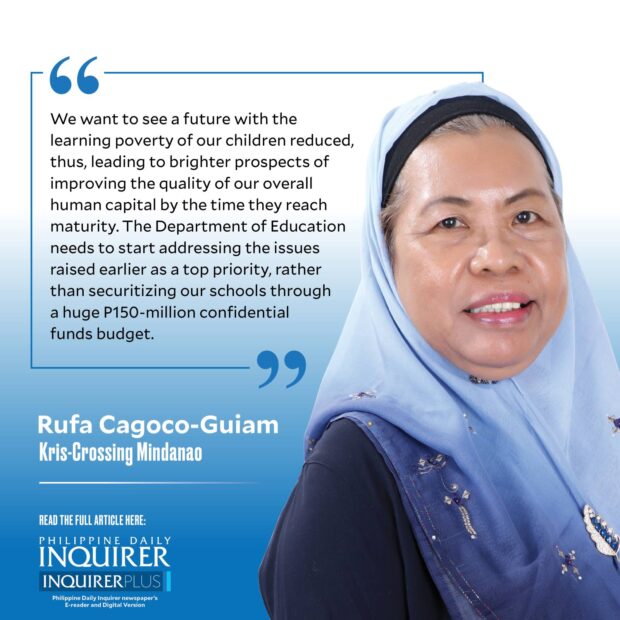Learning poverty and human capital indices
 In 2022, the World Bank (WB) reported the country’s learning poverty at 91 percent, considered to be one of the highest rates among countries in Southeast Asia and the Pacific. Learning poverty rate refers to the number of 10-year-old pupils who cannot read and understand age-appropriate texts or written materials. A report also noted that this rate is higher than the previous year’s learning poverty statistics, at 90 percent.
In 2022, the World Bank (WB) reported the country’s learning poverty at 91 percent, considered to be one of the highest rates among countries in Southeast Asia and the Pacific. Learning poverty rate refers to the number of 10-year-old pupils who cannot read and understand age-appropriate texts or written materials. A report also noted that this rate is higher than the previous year’s learning poverty statistics, at 90 percent.
A year later, in 2023, the Philippines maintained this rate, with WB reporting that the country is still among eight countries that registered a learning poverty rate higher than two-thirds, or 67 percent after the country restored face-to-face classes in November 2022. The Philippines shares the same state of learning with countries like Cambodia, Kiribati, Lao PDR (Laos), Myanmar, Papua New Guinea, Tonga, and Tuvalu.
WB experts argue that learning poverty occurs even when majority of children are in school, and even before the devastating COVID-19 pandemic, learners in many countries like the Philippines were already learning deprived. According to WB, learning crises like this contribute immensely to measuring human capital deficits, thus leading to “intergenerational poverty and vulnerability.” Through its Human Capital Project, WB hopes to raise awareness of the costs of not addressing learning poverty globally. It argues that if not addressed, the human capital index (HCI) scores of 0.56 across many countries in the world would mean that “by the age of 18, a child born today will only be 56 percent as productive as a child would be under the benchmark of a complete education, and full health” and that “shortcomings in the quality and quantity of schooling are a leading contributor to this human capital deficit.”
All these point to understanding that getting a child to school is not the end goal of education—it is only the first step among many. It is a recognition that there are multiple factors involved in getting children to be educated. They may be physically in school, but they are not learning enough to be able to grow toward becoming functioning, functional, and socially prepared individuals by the time they reach maturity, pegged at age 18.
There are multiple factors affecting why children are not learning, even when they are in school. These factors start with the state of health of the children, and the households where they come from. Isy Faingold, education chief at the Philippine office of the United Nations Children’s Fund (Unicef) noted that even before children go to school, they are already confronted with so many problems. Foremost among these is the poor health of many pupils, 30 percent of whom are stunted due to malnutrition, and while schools have feeding programs, these are not adequate and not regularly provided throughout the year, says Diane Fajardo of Philippine Business for Education (PBEd). A poorly nourished child comes from equally food-deprived households. The lack of proper nutrition contributes hugely to children’s capacities for appropriate responses to teachers’ instruction, leading to their inability to understand daily lessons.
Another problem that Unicef cited is also the lack of adequate pre-school education. While preschool has been required since the start of implementing the K-12 curriculum in basic education since 2013, not all pupils go through a universal preschool education. By Unicef estimates, 30 percent of pupils are not enrolled in kindergarten, and this is even worse for preschoolers. Poverty is often cited for not sending preschool-age children to early childhood learning centers since many of these centers are privately owned businesses that charge hefty enrolment rates.
This year, PBEd reported four major pressing issues hounding Philippine education that have exacerbated the learning poverty of our children. These are the declining mental health among students and teachers; lack of support for teachers; a culture of “mass promotion” of learners, and the lack of proper assessments of both the teaching and learning processes.
Are DepEd officials aware of these pressing issues and factors? Have they factored these in calculating how the new proposed budget of almost P800 billion can address these? Are these issues including those cited by WB, Unicef, and PBEd not strong enough to redirect the P150 million budget for confidential funds to improve the state of children’s basic education?
We want to see a future with the learning poverty of our children reduced, thus, leading to brighter prospects of improving the quality of our overall human capital by the time they reach maturity. The Department of Education needs to start addressing the issues raised earlier as a top priority, rather than securitizing our schools through a huge P150-million confidential funds budget.
Comments to rcguiam@gmail.com




















